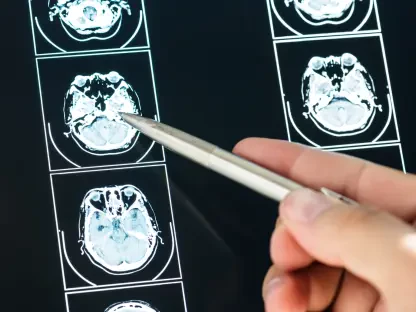James Maitland is a recognized specialist in the utilization of robotics and the Internet of Things (IoT) within medicine. His dedication to advancing healthcare technology has positioned him as a thought leader in the industry. Today, we delve into the transformative impact of AI on personalized medicine and patient care, the complexities of managing healthcare data, and how companies like OM1 are pioneering new strategies to realize the promise of AI in healthcare.
Can you tell us about the transformative moment we are seeing in healthcare with AI?
We are indeed at a pivotal crossroads in healthcare, driven by the rapid advancements in AI. This transformation isn’t just a single innovation; it’s a multitude of integrated technologies reshaping how we handle patient data, diagnose conditions, and personalize treatment plans. The potential scale and impact of this revolution are unparalleled, promising to enhance patient care significantly.
How does AI have the potential to revolutionize personalized medicine and improve patient care?
AI’s capability to analyze various types of patient data—from genomics and medical imaging to electronic health records and wearable devices—is unprecedented. By harnessing this data, AI can identify specific health patterns and predict outcomes with high accuracy, leading to tailored treatment plans that address the unique needs of individual patients and improve overall care quality.
What are the main challenges related to managing healthcare data?
The main challenges lie in the sheer volume and complexity of data. Healthcare professionals must navigate through diverse formats, standards, and regulatory requirements while ensuring data integrity and security. Managing this data efficiently is crucial for leveraging AI’s full potential in patient care and personalized medicine.
Why is healthcare data considered uniquely complex?
Healthcare data is uniquely complex because it encompasses various types of information, including clinical notes, medical imaging, lab results, vital signs, and genomic data. Each type of data requires different handling mechanisms and regulatory compliance, making the overall management extremely intricate.
Can you give examples of the different types of healthcare data?
Certainly. Healthcare data includes clinical notes from physicians that require natural language processing, medical imaging such as X-rays and MRIs, lab results that include numerical and categorical data, vital signs from wearable devices, and detailed genomic data that provide insights into a patient’s genetic makeup.
How do regulatory guidelines impact the handling of healthcare data?
Regulatory guidelines like HIPAA (Health Insurance Portability and Accountability Act) impose strict standards on the handling, storage, and sharing of healthcare data to protect patient privacy. These regulations shape how healthcare organizations design their data management systems, ensuring both compliance and security.
What are the specific challenges doctors face with large volumes of patient records?
Doctors often face the overwhelming task of navigating through extensive patient histories, which may consist of thousands of pages of medical records. This situation is compounded by the need to quickly identify relevant information to make informed decisions, placing significant strain on time and resources.
Why is it crucial to understand each patient’s unique medical journey?
Understanding each patient’s unique medical journey is vital because it encompasses their clinical history, symptoms, and treatment responses. Personalized medicine requires this detailed comprehension to tailor interventions that suit individual needs and optimize healthcare outcomes.
What additional challenge do healthcare providers face regarding cyberthreats and patient privacy?
Healthcare providers face the dual challenge of safeguarding sensitive patient information from an increasing number of cyberthreats while ensuring that data remains accessible and usable for clinical purposes. Protecting patient privacy without compromising the efficiency of data use is a delicate balance that must be maintained.
How has OM1 leveraged big clinical data and AI to gain patient insights?
OM1 has pioneered the use of real-world clinical data and AI to create comprehensive patient profiles that aid in predicting outcomes and comparing treatments. By integrating AI technologies into their data management systems, OM1 can extract actionable insights that enhance patient care and outcomes.
What initial challenges did OM1 face with its homegrown data processing environment?
OM1’s initial challenges included managing the complex and unstructured data from clinical notes and ensuring system reliability. Their homegrown processing environment struggled with stability issues, scaling jobs reliably, and presented a costly maintenance problem that hindered efficient data processing.
How did OM1’s managed Spark-based model struggle?
The Spark-based model faced issues with stability and job scaling, requiring intricate pipeline setups and manual cluster management. This disjointed process resulted in inefficiencies and difficulty in maintaining consistent performance across varying environments.
Can you describe OM1’s transition to Snowflake for data storage and processing?
OM1’s transition to Snowflake marked a significant milestone. They began by standardizing on SQL for structured data processing and utilized Snowpark alongside an ecosystem of integrated tools. This move streamlined their workflow, reduced complexity, and enhanced accessibility for data scientists and analysts who primarily operate with SQL.
What tools did OM1 integrate with Snowflake to streamline its data processing workflow?
OM1 integrated tools like Modelbit for machine learning engineering and Hex for authoring Python code, facilitating a more cohesive and efficient workflow. These integrations have enabled OM1 to simplify their data infrastructure and enhance the productivity of their data processing operations.
How did OM1’s new data strategy impact the cost and efficiency of their data processing operations?
OM1’s revamped data strategy led to a 75% reduction in processing costs and allowed them to analyze over 100 million records in under thirty minutes. This improvement was driven by the seamless integration of tools and the elimination of external frameworks, significantly enhancing both reliability and performance.
What role did security and HIPAA compliance play in OM1’s new infrastructure?
Security and HIPAA compliance were central to OM1’s updated infrastructure. By embedding security measures within their data systems and maintaining rigid compliance protocols, OM1 strengthened their posture against cyberthreats while ensuring that patient data remained protected and accessible.
How does the PhenOM® platform utilize AI for digital phenotyping?
The PhenOM® platform employs AI to perform digital phenotyping, analyzing vast amounts of patient data to identify specific phenotypes that can predict disease progression and treatment responses. This AI-driven approach enables OM1 to offer sophisticated, personalized care insights based on detailed patient profiles.
What are the benefits of simplified model deployment for AI models in OM1’s system?
Simplified model deployment has enabled OM1 to rapidly iterate and deploy AI models, translating complex algorithms into easily accessible services through SQL or APIs. This efficiency allows for faster implementation, testing, and refinement of AI-driven healthcare solutions.
Can you explain the potential impact of AI-driven personalized medicine in the future?
AI-driven personalized medicine holds the potential to revolutionize healthcare by providing highly tailored treatment options based on individual patient data. This future scenario could lead to the early identification of at-risk patients, optimized treatment plans, and improved overall health outcomes.
How can AI-powered insights help clinicians with treatment decisions?
AI-powered insights can guide clinicians by analyzing comprehensive patient data to provide suggestions on the best treatment paths. These insights help in understanding patient-specific factors, ensuring that clinical decisions are made with a thorough knowledge base, enhancing treatment efficacy.
What examples can you provide of AI identifying specific health risks or conditions?
AI can identify health risks such as elevated danger of abdominal aortic aneurysms by analyzing vast datasets of patient histories. Similarly, for conditions like treatment-resistant depression, AI can pinpoint critical signals from a patient’s medical data, guiding timely and effective interventions.
How does AI enhance, rather than replace, clinical judgment?
AI acts as a tool to augment clinical judgment by providing additional insights and data-driven recommendations. It doesn’t replace the expertise of clinicians but supports them in making informed decisions, thereby improving the accuracy and quality of patient care.
What lessons has the healthcare industry learned from moving from paper records to AI-powered systems?
The transition from paper records to AI-powered systems has taught the healthcare industry the importance of interoperability, data security, and the need for continuous innovation. The focus must always remain on using technology to improve patient care and streamline operations without compromising on the human element.
How does OM1 envision the future of AI in personalized medicine for patient care, research, and innovation?
OM1 envisions a future where AI-driven personalized medicine becomes the norm, allowing for highly accurate patient care guided by detailed data insights. They foresee innovations that will enhance treatment efficacies, drive groundbreaking research, and bring about significant advancements in how we understand and address various health conditions.









